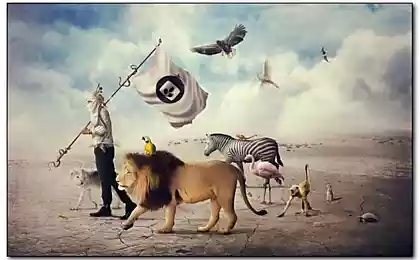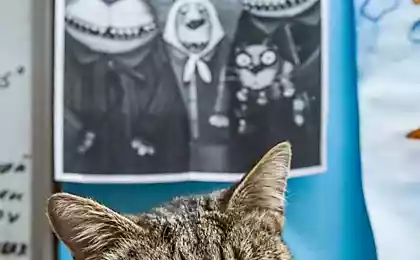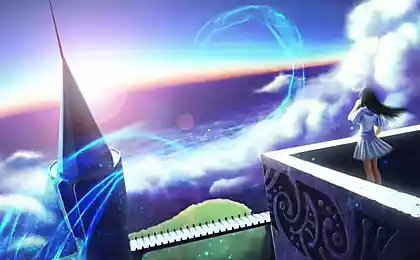582
5 amazing sense organs of animals.
Will text + 5 ph.
1. Shellfish with stone eyes
Armoured shellfish or tunic to look at anything interesting in itself is not - similar to woodlice. But he has something really amazing - stone eyes. We do not want to say that this creature's eyes look like stone. They consist of aragonite - the form of limestone, the man who is part of the mollusk shells.
And no stone eye on the clam shell may be several hundred.
Shellfish somehow manage to achieve the optical properties of the material from which we build a house, and "do" out of it ... As an optical lens - a scientist is only to be seen. Although eyesight chitons are not so much, but their stone eyes it is able to distinguish light from shade, and even distinguish the shape of the object.
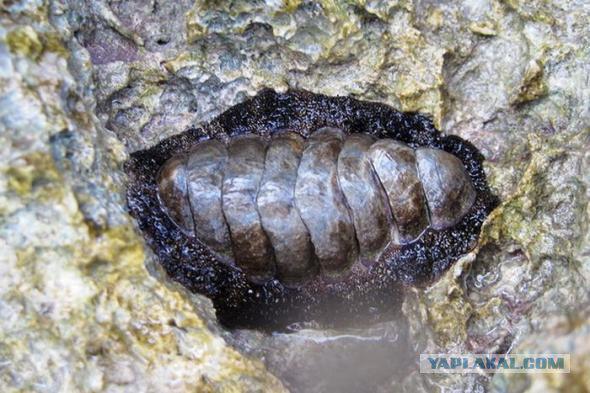
2. Fish ghost hunts and conducts surveillance at the same time, with the help of a mirror
Fish Ghost (family barreleye) - one of the most unusual occupants of the deep sea. Association with the nightmare she won thanks to the eyes - two large orange spheres.
In order not to get caught in the teeth of a predator, this fish should be on the alert all the time - even when the hunt itself. That is, it needs all-round visibility. And she has this.
Fish eyes ghost divided into two parts, so it may look backwards and forwards and in the same time. It's like having an extra pair of eyes in the back of his head.
Only in the case of our fish is not a separate pair of eyes, and a complex system with built crooked plates resembling a mirror that capture subtle glow of half a kilometer below the surface. So it's probably not even eye on his head, and a pair of special glasses with built-in mirrors, which allow you to see what is happening behind.
When the fish is sent to a ghost-hunting, small chёrnenkie eyes that you see on the sides, looking for a future meal. And that looks like a large orange eyes from above - the reverse side of the mirror surface, which captures the glow and the biological warns of predators.
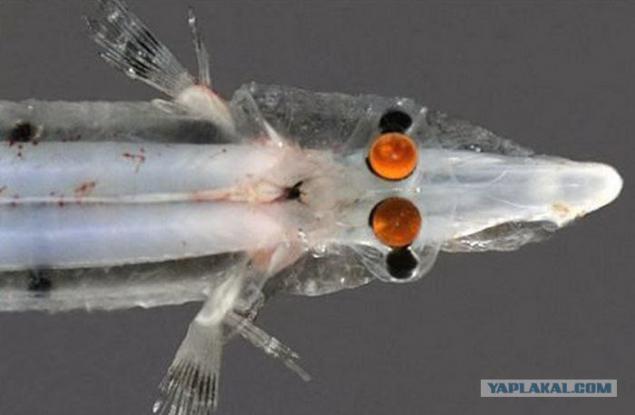
3. Catfish - a giant floating tongue
The man in the middle has 10,000 lingual papillae. And they are all concentrated in one place - in the language. According to the same neurophysiology and, concurrently, a specialist in fish, catfish have a length of 15 centimeters taste buds is not less than 250 000. And they had located all over the body. That is, where you will touch him not, he always feels, what you taste. If it is, of course, not fried.
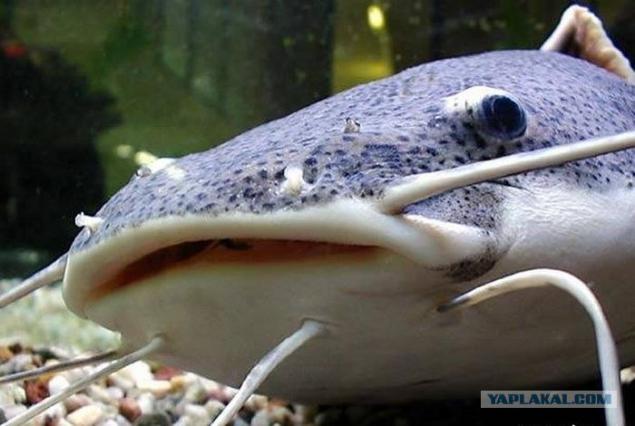
4. bats "see" our circulatory system
Bats (the kind that is called "vampires") - the only mammals that feed on blood. With this gastronomic passions associated exceptionally fine development of the senses, through which, by the way, the bats have received from Mother Nature a very unsightly nose. This feeling allows animals to "see" the blood coursing through your veins.
Nose "Vampire" is equipped with a kind of infrared detector reacts to changes in body temperature - at a distance. This is surprising because other mammals, including us, have to touch the object to tell it warm or cold. But the most striking another: they are able to determine which Vienna is most interest to them.
Their "heat sensors" are so perfect that they do not have to waste time, several times running teeth into the flesh of his victim. "Vampires" go directly into the vein, and always on the first try.

5. Narwhal tusk - the giant sensitive organ
For a long time scientists have wondered why this strange narwhal tusk, Tochal head. And, finally, we found. First of all, it turned out to be the tusk does not even tusk and tooth. One (occasionally two) long twisted spiral tooth, covered with ten million nerve endings.
Studies have shown, for example, that the narwhal tooth can determine the degree of their salinity. Why should they? The salt content influences the freezing of water. And if you live among ice floes and breathe air, it is important you know that at any moment you will be able to rise to the surface.
So tusk, tooth - a device that is able to predict the formation of ice. And not only. He can determine the temperature, water pressure, and if it is raised in the air - and the barometric pressure.
ALL.
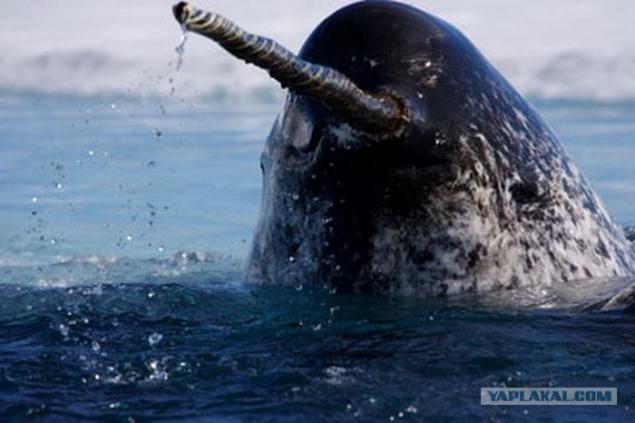
Source:
1. Shellfish with stone eyes
Armoured shellfish or tunic to look at anything interesting in itself is not - similar to woodlice. But he has something really amazing - stone eyes. We do not want to say that this creature's eyes look like stone. They consist of aragonite - the form of limestone, the man who is part of the mollusk shells.
And no stone eye on the clam shell may be several hundred.
Shellfish somehow manage to achieve the optical properties of the material from which we build a house, and "do" out of it ... As an optical lens - a scientist is only to be seen. Although eyesight chitons are not so much, but their stone eyes it is able to distinguish light from shade, and even distinguish the shape of the object.

2. Fish ghost hunts and conducts surveillance at the same time, with the help of a mirror
Fish Ghost (family barreleye) - one of the most unusual occupants of the deep sea. Association with the nightmare she won thanks to the eyes - two large orange spheres.
In order not to get caught in the teeth of a predator, this fish should be on the alert all the time - even when the hunt itself. That is, it needs all-round visibility. And she has this.
Fish eyes ghost divided into two parts, so it may look backwards and forwards and in the same time. It's like having an extra pair of eyes in the back of his head.
Only in the case of our fish is not a separate pair of eyes, and a complex system with built crooked plates resembling a mirror that capture subtle glow of half a kilometer below the surface. So it's probably not even eye on his head, and a pair of special glasses with built-in mirrors, which allow you to see what is happening behind.
When the fish is sent to a ghost-hunting, small chёrnenkie eyes that you see on the sides, looking for a future meal. And that looks like a large orange eyes from above - the reverse side of the mirror surface, which captures the glow and the biological warns of predators.

3. Catfish - a giant floating tongue
The man in the middle has 10,000 lingual papillae. And they are all concentrated in one place - in the language. According to the same neurophysiology and, concurrently, a specialist in fish, catfish have a length of 15 centimeters taste buds is not less than 250 000. And they had located all over the body. That is, where you will touch him not, he always feels, what you taste. If it is, of course, not fried.

4. bats "see" our circulatory system
Bats (the kind that is called "vampires") - the only mammals that feed on blood. With this gastronomic passions associated exceptionally fine development of the senses, through which, by the way, the bats have received from Mother Nature a very unsightly nose. This feeling allows animals to "see" the blood coursing through your veins.
Nose "Vampire" is equipped with a kind of infrared detector reacts to changes in body temperature - at a distance. This is surprising because other mammals, including us, have to touch the object to tell it warm or cold. But the most striking another: they are able to determine which Vienna is most interest to them.
Their "heat sensors" are so perfect that they do not have to waste time, several times running teeth into the flesh of his victim. "Vampires" go directly into the vein, and always on the first try.

5. Narwhal tusk - the giant sensitive organ
For a long time scientists have wondered why this strange narwhal tusk, Tochal head. And, finally, we found. First of all, it turned out to be the tusk does not even tusk and tooth. One (occasionally two) long twisted spiral tooth, covered with ten million nerve endings.
Studies have shown, for example, that the narwhal tooth can determine the degree of their salinity. Why should they? The salt content influences the freezing of water. And if you live among ice floes and breathe air, it is important you know that at any moment you will be able to rise to the surface.
So tusk, tooth - a device that is able to predict the formation of ice. And not only. He can determine the temperature, water pressure, and if it is raised in the air - and the barometric pressure.
ALL.

Source:


